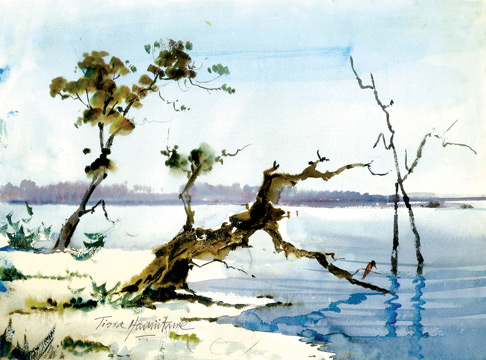Reflections on the water
by Tissa Hewavitarane
To become a skilled landscape painter, it takes years of practice.
However, starting from a few basic notions it is possible to paint an
acceptable landscape which, like creating skies, trees, mountains and
valleys can be applied in general landscapes. Painting reflections is
naturally, part of river scenes and sea views.
To get a good reflection on the water it is necessary to bear in mind
that the reflections painted in watercolours depend fundamentally on the
back ground of the composition and the dark colour that is used for the
reflection.
 Reflections in general obey certain laws. It is much easier to
understand them if you try to observe and make a study of large
stretches of water the surface of which is made very light and where
it's further away and dark in the foreground. This is because the
horizon reflects the low, lighter part of the sky, but close to the
shore the water picks up the darker colour from the sky above. Also
because we're looking down at it, the foreground water transmits some of
the colour of the bottom. With a large body of water, some parts of the
surface are smooth while others are ruffled by wind. Reflections in general obey certain laws. It is much easier to
understand them if you try to observe and make a study of large
stretches of water the surface of which is made very light and where
it's further away and dark in the foreground. This is because the
horizon reflects the low, lighter part of the sky, but close to the
shore the water picks up the darker colour from the sky above. Also
because we're looking down at it, the foreground water transmits some of
the colour of the bottom. With a large body of water, some parts of the
surface are smooth while others are ruffled by wind.
Smooth water reflects the sky like a mirror but rough water picks up
and relays the light from many directions, either darker or lighter than
the sky depending on the prevailing conditions.
The majority of the techniques necessary to paint a river landscape
are gradation in the background, trees and vegetation in the distance
and the sky.
The zone of the water always has to be painted somewhat darker than
the sky. The brush strokes have to belong and continuous so as not to
make breaks in the superimposition.
Confusing
Water is one of the most popular painting subjects. Yet it isn't an
easy one to get right. Reflections in particular, can be confusing and
are often not well understood. Painting reflections in water takes
practice and close observation. Novice painters usually come unstuck
because, first, they don't understand the way reflections behave and
second they are too timid in their approach.
Fluid and transparent, watercolour is tailormade for painting
reflections in water.
There are many techniques you can use, depending on the effect you
want to convey. In the painting I have shown here, note the reflection
of trees rendered with dark limpid washes that give a life-like
impression of the smooth and gently undulating surface of the water.
Note that the ripples are larger in the foreground. Expressive brush
strokes give a sense of movement. Sharp contrasts of tone between water
and reflections give a "glassy" look to the water.You've probably heard
the saying "Less is more" and nowhere does this apply more readily than
in the painting of water. Achieving the smooth glassy look of water
requires surprisingly little effort.
Often a few sweeping strokes with a broad brush on damp paper are
enough to convey the effect you want. Yet, beginners often seem to think
that there must be more to it than that and insist on putting in a few
odd strokes and ripples here and there for good measure.
Damp paper
Whether you apply your colours to dry paper or damp paper is a matter
of preference, but there's one more important piece of advice. Choose
your colours with care and apply with confidence.
The more decisively and simply you paint water the wetter it looks,
so try to work with large brushes that discourage the habit of fiddling
and prodding and use plenty of water to facilitate smooth, even strokes.
Mix your colours carefully on the palette and test them on scrap
paper before committing yourself remembering that they should appear
quite dark in tone to allow for the fact that they will fade a lot on
drying.
To paint moving water well requires fast moving brush strokes.
One deft squiggle can convey far more than any amount of hesitant
goings-over, so take your courage in both hands and allow the brush to
follow the movements of the water.
Rhythmic strokes
Observe how I have used strong rhythmic brush strokes to impart a
sense of movement and encourage the eye to follow the progress of the
water. Note the contrast between the water, which is painted with thin
paint and very light tomes, and the surrounding landscape elements which
are painted with more definition and stronger tones.
This dark tones and solid shapes make the water appear more fluid and
fast-flowing through the confident use of contrast.
The circular movement of the brush stroke depicting the reflection of
the trees generates a sense of life and movement and makes us feel
actively involved in the picture.
Always try to imagine a river or lake as a soft mirror, reflecting
everything above it. Apart from when it is muddy and in flood a river
reflects the colour of the sky, blue or stormy grey. Secondly, it
reflects the things that surround it, trees, huts, earth and bridges all
of course upside down. |

